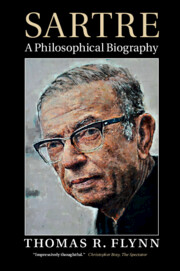Book contents
- Frontmatter
- Dedication
- Contents
- Preface
- Acknowledgments
- Abbreviations
- 1 The childhood of a genius
- 2 An elite education: student, author, soldier, teacher
- 3 Teaching in the lycée, 1931–1939
- 4 First triumph: The Imagination
- 5 Consciousness as imagination
- 6 The necessity of contingency: Nausea
- 7 The war years, 1939–1944
- 8 Bad faith in human life: Being and Nothingness
- 9 Existentialism: the fruit of liberation
- 10 Ends and means: existential ethics
- 11 Means and ends: political existentialism
- 12 A theory of history: Search for a Method
- 13 Individuals and groups: Critique of Dialectical Reason
- 14 A second ethics?
- 15 Existential biography: Flaubert and others
- Conclusion: the Sartrean imaginary, chastened but indomitable
- Select bibliography
- Index
- References
Conclusion: the Sartrean imaginary, chastened but indomitable
Published online by Cambridge University Press: 18 December 2014
- Frontmatter
- Dedication
- Contents
- Preface
- Acknowledgments
- Abbreviations
- 1 The childhood of a genius
- 2 An elite education: student, author, soldier, teacher
- 3 Teaching in the lycée, 1931–1939
- 4 First triumph: The Imagination
- 5 Consciousness as imagination
- 6 The necessity of contingency: Nausea
- 7 The war years, 1939–1944
- 8 Bad faith in human life: Being and Nothingness
- 9 Existentialism: the fruit of liberation
- 10 Ends and means: existential ethics
- 11 Means and ends: political existentialism
- 12 A theory of history: Search for a Method
- 13 Individuals and groups: Critique of Dialectical Reason
- 14 A second ethics?
- 15 Existential biography: Flaubert and others
- Conclusion: the Sartrean imaginary, chastened but indomitable
- Select bibliography
- Index
- References
Summary
With a simile that could be read as the summation of his philosophic anthropology, Sartre remarks late in his career: “Man is like a leak of gas slipping into the imaginary” (BEM 46). We have witnessed this slippage in its various occurrences throughout his career. Describing the arguments that often arose between Sartre and Aron as young adults, for instance, Simone de Beauvoir noted how aggressively analytic was Aron’s approach: “‘There are two alternatives, mon petit comarade,’ he would say. ‘Take your choice’ … Sartre struggled hard to avoid being cornered, but as there was more imagination than logic in his mental processes, he had his work cut out” (Prime 33). Of course, Sartre’s imagination was never “free-floating.” It always built on a perceptual core that it could “derealize” as he saw fit. His existential biographies confirm this tension between the imaginary and the real – the “novel which is true.”
Michel Sicard observed that “one can never emphasize sufficiently how Sartre’s first philosophy is grounded in a theory of the image.” That theory, we have argued, found a ready home in the “eidetic” reduction (free, imagination variation of examples) central to the descriptive method of phenomenology. And when conjoined with the phenomenological concept of intentionality, it saved him from the “illusion of immanence,” with its thesis that the image is a mental likeness of an extramental phenomenon. Rather, for Sartre, intentionality effects a “re-presentation” of the “presence” of Chavalier in an impersonation, for example, or the Renaissance in viewing Michelangelo’s “David,” or the living thing by simply regarding a tree in its physical reality. In other words, intentionality is Sartre’s antidote against idealist epistemology and aesthetics.
- Type
- Chapter
- Information
- SartreA Philosophical Biography, pp. 409 - 412Publisher: Cambridge University PressPrint publication year: 2014



